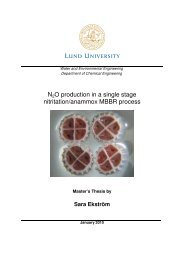Bättre EU-regler för en giftfri miljö - Kemikalieinspektionen
Bättre EU-regler för en giftfri miljö - Kemikalieinspektionen
Bättre EU-regler för en giftfri miljö - Kemikalieinspektionen
Create successful ePaper yourself
Turn your PDF publications into a flip-book with our unique Google optimized e-Paper software.
• The limit values for metals in baby food need to be reviewed, and the Swedish National<br />
Food Ag<strong>en</strong>cy is working on this issue.<br />
• There is a need to consider combination effects in a better manner.<br />
• There is a need for increased knowledge of nanomaterials.<br />
• In the application of the new rules regarding biocidal products, consideration needs to<br />
be giv<strong>en</strong> to possible risks to people’s health if biocidal products are employed in the<br />
vicinity of, or on, animals for food purposes or in contact with foods.<br />
Medicinal products (Chapter 6.3)<br />
Medicinal products are a category of chemical products covered by an <strong>EU</strong> legislation that is<br />
harmonised in many respects. The g<strong>en</strong>eral chemicals legislation (REACH etc.) largely does<br />
not apply to medicinal products. There is considerable concern regarding the effects of<br />
pharmaceutical substances which <strong>en</strong>d up in the <strong>en</strong>vironm<strong>en</strong>t, e.g. with regard to the<br />
developm<strong>en</strong>t of antibiotics resistance and the effects of <strong>en</strong>docrine-disrupting substances. With<br />
regard to the impact of medicinal products on the <strong>en</strong>vironm<strong>en</strong>t there are, however, a number<br />
of shortcomings in the <strong>EU</strong> legislation, which have be<strong>en</strong> addressed in several reports from the<br />
Swedish Medical Products Ag<strong>en</strong>cy and the Swedish Environm<strong>en</strong>tal Protection Ag<strong>en</strong>cy These<br />
shortcomings can be summarised as follows:<br />
• The <strong>en</strong>vironm<strong>en</strong>tal risk assessm<strong>en</strong>ts now being made in respect of medicinal products<br />
prior to authorisation must be improved and developed. Medicinal products with older<br />
authorisations (before 2005) also need to be assessed in terms of <strong>en</strong>vironm<strong>en</strong>tal risk.<br />
• It must be possible for <strong>en</strong>vironm<strong>en</strong>tal aspects to be considered in the risk/b<strong>en</strong>efit<br />
assessm<strong>en</strong>t made in connection with the authorisation of medicinal products for human<br />
use. Such consideration, under curr<strong>en</strong>t rules, can only be tak<strong>en</strong> in respect of veterinary<br />
medicinal products, but it is also needed in respect of human medicinal products. If<br />
<strong>en</strong>vironm<strong>en</strong>tal risks are to be weighed into the assessm<strong>en</strong>t, the compet<strong>en</strong>t authority for<br />
medicinal products can impose <strong>en</strong>vironm<strong>en</strong>t-related conditions in order to reduce the<br />
<strong>en</strong>vironm<strong>en</strong>tal impact, e.g. restrictions which are to be observed in use of the medicinal<br />
product.<br />
• In accordance with proposals from the Medical Products Ag<strong>en</strong>cy, rules should be<br />
introduced in the <strong>EU</strong> to counteract the release of <strong>en</strong>vironm<strong>en</strong>tally harmful pharmaceutical<br />
substances in the production of medicinal products. Work should be initiated in order to<br />
prioritise which substances need to be regulated. By linking these rules to existing rules<br />
regarding good manufacturing practice (GMP) they can, according to the assessm<strong>en</strong>t of<br />
the Medical Products Ag<strong>en</strong>cy, also have an impact in countries outside the <strong>EU</strong>.<br />
The Water Framework Directive is an important piece of <strong>EU</strong> legislation with regard to the<br />
managem<strong>en</strong>t of <strong>en</strong>vironm<strong>en</strong>tal risks in the aquatic <strong>en</strong>vironm<strong>en</strong>t. Under a new proposal, three<br />
substances which occur in medicinal products should be regarded as prioritised substances<br />
under the Water Directive, which means that measures need to be tak<strong>en</strong> wh<strong>en</strong> they occur in<br />
the aquatic <strong>en</strong>vironm<strong>en</strong>t. It is important to follow the discussion about this proposal. As well<br />
as the connection to the Water Directive there is a connection to the <strong>EU</strong>’s g<strong>en</strong>eral strategy for<br />
<strong>en</strong>docrine-disrupting substances and the discussion on combination effects, which we also<br />
address in the report.<br />
Cosmetics (Chapter 6.4)<br />
The <strong>EU</strong> rules on cosmetics have rec<strong>en</strong>tly be<strong>en</strong> updated and are to be found in a new<br />
regulation. The legislation is harmonised and deals with health aspects of the products. In the<br />
rules there are exhaustive lists of substances which are not allowed in the products and<br />
23















